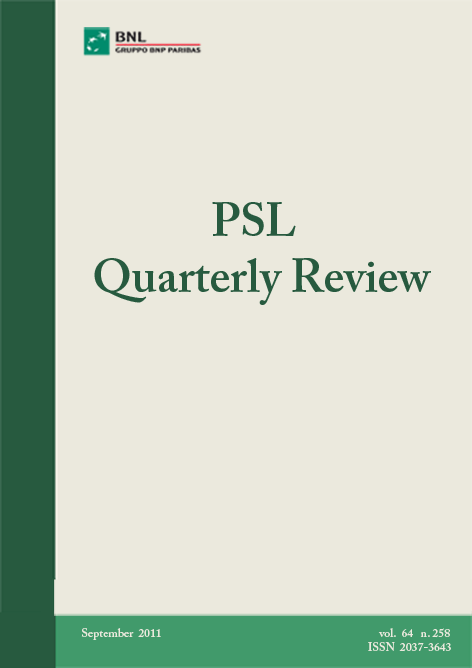Will restricting proprietary trading and stricter derivatives regulation make the US financial system more stable?
DOI:
https://doi.org/10.13133/2037-3643/9410Keywords:
financial regulation, naked CDS, Volcker Rule, Dodd‐Frank, Lincoln AmendmentAbstract
Two of the major provisions of the Dodd‐Frank Wall Street Reform and Consumer Protection Act, passed into law on July 21 2010, aim to reduce speculation with financial institutions own funds using highly leveraged derivatives. The so‐called “Volcker rule” limits the ability to trade as principal in what is known as “proprietary trading” and the Lincoln Amendment or the “push out” rule limits derivatives dealing for regulated, insured banks. A complement to the Lincoln amendment requires that all over the counter derivatives be cleared through official mechanisms and traded on regulated exchanges similar to those used for commodities.
JEL Codes: E11, G01, B50, H12
References
DTCC (2008) “DTCC successfully closes out Lehman Brothers bankruptcy largest closeout in DTCC history; prevents losses for industry”.
EISINGER J. and BERNSTEIN J. (2010) “The Magnetar trade: how one hedge fund helped keep the bubble going”, ProPublica, April 9.
FENDER I., FRANKEL A. and GYNTELBERG J. (2008), “Three market implications of the Lehman bankruptcy”, 8 December; extract from pages 6-7 of BIS Quarterly Review, December 2008.
GREENSPAN A. (2002) “International financial risk management”, Remarks by Chairman Alan Greenspan before the Council on Foreign Relations, Washington (DC), November 19, 2002.
HARRINGTON S.D. (2008), “Credit swap clearinghouse to be running by year-end (Update 2)”, November 14, Bloomberg.
KREGEL J. (2008), “Minsky’s cushions of safety: systemic risk and the crisis in the U.S. subprime mortgage market”, Public Policy Brief, n. 93, Annandale-on-Hudson (NY): The Levy Economics Institute of Bard College.
LEWIS M. (2010), The big short, New York: Norton.
MCDONALD L.G. and ROBINSON P. (2009), A colossal failure of common sense: the inside story of the collapse of Lehman Brothers, New York: Crown Business.
MOLLENKAMP C. and NG S. (2007), “Wall Street wizardry amplified credit crisis: a CDO called Norma left ‘hairball of risk’; tailored by Merrill Lynch”, The Wall Street Journal, December 27.
MOLLENKAMP C. and NG S. (2008), “A fund behind astronomical losses”, The Wall Street Journal, January 14.
SMITH Y. (2010), Econned: how unenlightened self interest undermined democracy and corrupted capitalism, New York: Palgrave Macmillan.
TAVAKOLI J. (1998), Credit derivatives: a guide to investments and applications, New York: John Wiley & Sons.
TAVAKOLI J. (2003), Collateralized debt obligations and structured finance, New York: John Wiley & Sons.
TAVAKOLI J. (2009), Dear Mr. Buffet, New York: John Wiley & Sons.
NATIONAL COMMISSION ON THE CAUSES OF THE FINANCIAL AND ECONOMIC CRISIS IN THE UNITED STATES (2011), The financial crisis inquiry report, Final report of the National Commission on the Causes of the Financial and Economic Crisis in the United States, submitted pursuant to Public Law 111-21, Washington (DC): US Government Printing Office, January.
UNITED STATES SENATE PERMANENT SUBCOMMITTEE ON INVESTIGATIONS, COMMITTEE ON HOMELAND SECURITY AND GOVERNMENTAL AFFAIRS (2011), Wall Street and the financial crisis: anatomy of a financial collapse. Majority and minority staff report, Washington (DC), April 13.
Downloads
Published
How to Cite
Issue
Section
License



